Thomason, J. (McKechnie Section 4)
See also Sections Three and Five
An artist, recorded by Jackson (The History of Silhouettes), who is known to have worked in the north of England and Dublin, and who may have worked in London and Scotland, but of whose origins and early life nothing is known.
Foskett mentions a pen-and-ink miniature of Charles I (?1704), which was lent in 1865 to the South Kensington Museum by Sir Philip de Malpas Grey Egerton and was by an artist named Thomasen. In the catalogue of this exhibition, Thomasen is described as `Master of a Grammar School in Cheshire at the beginning of the 18th. Century and noted as a calligrapher'. Jackson believed that Thomason, the profilist, worked for a time in Cheshire, and it is just possible that Thomasen may have been an ancestor, but the connection seems tenuous. Also, some writers have suggested that Thomason was a Leeds man and that he was a pupil of Miers. The basis for this supposition is that Shillito, the printer of some of Miers's early trade labels, also printed labels for Thomason. It is possible that Thomason visited Leeds while Miers was working there, but the available contemporary records of the city for the relevant period (1786-90), for which no street directories have survived, contain no reference to Thomason. There is no evidence, moreover, that Thomason was a pupil of Miers, although he may have derived some ideas from seeing examples of Miers's work.
The earliest certain record of Thomason's work stems from Manchester. On Trade Label No. 1, used in this city, the price of 8s for jewellery work is quoted. In an advertisement published in Leicester on 9 June 1787 (quoted later) the higher price of 10s. 6d. is given. We must therefore conclude that Thomason was in Manchester before the date of the Leicester advertisement. He may have worked in Manchester at various dates, since the quality of his silhouettes, bearing labels with a Manchester address, varies considerably. One silhouette of a woman (illustrated), bearing the Manchester label, may have been painted in 1786, or possibly on a later visit to the city. Another silhouette of a man, with the same label, owned by Mrs de Peyer, is painted in the same style as the mediocre illustrated profile of James Wyatt, of Coventry, which is inscribed with the sitter's name and the date, August 1787. Another silhouette, painted in Manchester, is the well known profile of George Washington, at Sulgrave Manor (illustrated by Jackson; Dictionary), which shows work of indifferent finish but is much better than the profile of James Wyatt. The Manchester profiles bear labels with an address at `Mr William Cooper's, Dolefields', but contemporary city records yield no information about either Thomason or Cooper.
The advertisement published in Leicester, referred to above (Leicester Journal, 9 June 1787), reads as follows:
MOST STRIKING LIKENESSES
In MINIATURE PROFILE
By J. THOMASON.
On an entire new Plan, allowed by every observer to be far superior to any offered here before At Mr. STONE's, Soe-maker [sic], Swines Market, LEICESTER
Time of sitting one minute
Apprehending that a method might be devised of taking shades, in which the expression and animation of the features might be better preserved than hitherto has been by doing them on paper, a PLAN is now offered to the Public, on which are produced the most STRIKING LIKENESSES that were perhaps ever seen before in SHADE, dressed in a stile of elegance and neatness, that cannot fail of meeting approbation — set in elegant gilt frames, at 5s 6d. only — in handsome (ladies) gilt lockets and bracelets at 10s 6d — for rings, pins, &c., a proportionable price.
Persons residing in the country, having shades by them, may by remitting them, have them copied from any size, and returned with all possible dispatch.
Thomason, then, may have visited Manchester in 1786 or early 1787, was certainly in Leicester in June 1787 and presumably in Coventry in August of the same year. He may have revisited Manchester in 1788 or 1789. It is possible that he visited other towns in the counties where Jackson considered that he worked (Cheshire, Lancashire, and Staffordshire) during these years. Jackson also believed that he worked in London, but this theory is not supported by any documentary evidence, or any silhouettes, known to me.
Jackson tells us that Thomason was a follower of John Wesley, and that he painted a profile of Wesley from life; but she does not tell us where he painted it.
Since Wesley died on 2 March 1791, Thomason presumably painted the profile before leaving for Dublin, where he first advertised 16 March 1790, and where he spent the most fully documented period of his career.
In his Dublin advertisements Thomason stressed his desire for orders from country-dwellers even more strongly than he did in his Leicester advertisement. Thomason's object was to post instructions for the securing of the basic outline of a profile to his customers, who would then post their efforts back to him for painting. The silhouettes painted on plaster slabs, which in due course he presumably sent out to his customers, must have required careful packing. After arrival in Dublin, Thomason used for about two months a label printed by Shillito of Leeds, which he had probably ordered before he left England, although he may have despatched an order after he had found suitable premises in Dublin; in the latter case, he may have been in Dublin as early as January 1790. This label (No. 2) is scarce. It gives the price of 5s 6d for plaster profiles; by 18 May, when Thomason advertised in the Dublin Chronicle, the price had risen to 5s 111/2d. The advertisement reads as follows:
Striking Likenesses in Miniature Profile
By I. THOMASON, from ENGLAND
Delivered set in elegant Gilt Frames with Convex Glasses at 5s. 111/2d., or done for Rings, Bracelets, Lockets, Pins, Watch-seals, Pocket-Cases, &c., at No. 25 South Great George's Street, Dublin.
Time of sitting One Minute
His Likenesses are more strong and animated than ever appeared here before in Shade, finished and softened off on white composition in a superior stile of taste and elegance.
As one main object of his setting here is to accommodate Country People, he hath something new and particular to propose:- Any number of Ladies or Gentlemen, not less than three, desirous of getting Shades, but do not come to Town, may, by directing a line as above, have such Instructions sent as will enable even those who do not draw to take correctly each other's Shade from Life, which may be sent to be finished in town, and they may rely on having the same justice done them, and every mistake as punctually rectified as if present on the spot, without any additional charge whatever:- All orders post paid will be duly attended
to.
Attendance given from Ten to Six in the evening every day.
How Thomason could undertake to rectify mistakes in profiles of sitters whom he had not seen is baffling. This advertisement shows how much use he made of the postal services. Perhaps the 51/2d more which he was now charging for his profiles covered postal charges: the price of 5s. 111/2d. was presumably charged in the interim period between the use of Trade Labels Nos 2 (5s 6d) and 3 (6s 6d). At this time Thomason was competing in Dublin with C. H. Sandhegan (who offered his work at about the same figure; see Section Three) and W. L. Holland (see also Section Three), who was charging the outrageous price of £5 5s. It is likely that Thomason's arrival in the city ultimately put Holland out of business.
At some date before May 1792 Thomason moved his studio to 33 Capel Street, and printed another label, with this address. He seems to have been very successful during his stay in Dublin, to judge by an advertisement published in May in the Dublin Chronicle, in which he announces his intention of returning to (presumably) England. In this announcement, issued from Capel Street, he 'returns his most grateful acknowledgements to the Public for the extraordinary encouragement given him. He informs them that he has determined to leave early in May, and therefore requests those who wish for good Likenesses not to let slip an opportunity, that perhaps will never return, also requests those who have any Shades left with him to send for them, and that all old Shades wanted to be reduced may be sent on to him as his departure is positively determined on.'
We know that Thomason did leave Dublin for England in 1792, presumably fairly soon after issuing this advertisement (although the threat to leave a locality was a standard ruse of silhouette artists who wished to encourage business), but we do not know exactly when he returned to England or where he lived after he had arrived there. Perhaps it was at this stage of his career that he worked in London (if Jackson is correct in stating that he did work in London at some time). The thriving trade being plied in the capital at that time by artists of the standing of Miers, Mrs Beetham and Charles, however, would probably have presented Thomason with competition too powerful to permit him to achieve much success. The illustrated silhouettes of the Donald family, dated April 1794, offer tenuous evidence that Thomason may have visited Scotland at this date. In Section Three I suggest that certain silhouettes painted on glass, possibly by Thomason, date from 1799-1800; if these suppositions are correct, his career continued at least until the closing years of the century.
Although we know that Thomason worked as a silhouette artist in England for at least three years before he went to Dublin, little of this early work is available. One example, painted in Manchester, is the silhouette of George Washington mentioned above. This is in plain black; the shirt-frill is shown without special finesse, although there is some deft painting on the sitter's pigtail. I have already mentioned the similarity in style between the silhouette of a man, painted in Manchester and owned by Mrs de Peyer, and the illustrated profile of James Wyatt, taken in Coventry in 1787. The latter shows a shirt-frill painted much in the style of that seen on the profile of Washington, but the bust-line differs, being finished in a double loop, with a marked peak at the junction of the arm with the rest of the profile. Much more sophisticated in style is the profile of a woman (painted in Manchester) in the Pollak collection. The painting on this example is most realistic; compared with the feathers worn by this sitter, those seen on the work of Miers, even at his best, appear to lack substance. Careful shading gives precision to the shape of the sitter's hat, the buffon is well shown, and Thomason took the trouble to add the frill of the low-necked gown with which this was often worn. On the other hand, he was fess skilful than Miers at painting hair. His best profiles, both of men and of women, show the sitter wearing a hat, and such silhouettes occupy a higher proportion of Thomason's output than of Miers's.
While in Dublin, Thomason painted most profiles in dead black; later, however, he began to favour a dark-greyish hue, just pale enough to show strokes of dead black painted and hatched across it in order to indicate clothing detail. Initially he seems to have adopted this style only for profiles of men, but most later profiles of both men and women, dating from c. 1792 onwards, show clothing detail painted in this fashion, as on an illustrated profile of a girl on which the frill about the neckline of her dress is very elegantly rendered.
During Thomason's Dublin period, the bust-line finish of his silhouettes plunges towards the front more markedly than on his earlier work. On some silhouettes of women the point at the back of the bust-line termination is obscured by the sitter's à la conseilleur hair-style; when visible, it appears rather sharp — though, on account of the plunging bust-line, less sharp than on Miers's work.
Silhouettes painted after Thomason's return to England show a more skilful treatment of hair; the wire-like effect seen on some of the earlier work is replaced by much neater and better defined brush-work. He had already adopted this style by the end of his Dublin period, as is shown by the profile of Mrs Reay, painted in 1792 and illustrated by Mills. This example shows carefully painted detail on a dormeuse cap; the bust-line is squared off across the arm. In general, there is more variety in the bust-line of Thomason's later silhouettes: some are almost horizontal, others are in the form of a straight line across the termination of the arm, with only a shallow plunge towards the front.
Most of Thomason's silhouettes are in oval hammered brass frames, usually with convex glass. One example, however (which, although unlabelled, must, judging by the treatment of the hat and the hair, be Thomason's work), is framed in pearwood, with fine verre églomisé. It probably dates from c. 1793. The glass is different in design from the usual leaf-and-border pattern.
Five trade labels are known. No. 1 (illustrated) was used in Manchester, possibly from 1786 and possibly during more than one visit to the city. The address given is `Mr. Wm. Cooper's, Dolefield, Manchester'. It was printed by Shillito of Leeds.
Trade labels Nos 2 - 4 were used in Dublin. No. 2 is exactly the same in format as No. 1, and was likewise printed by Shillito Sc. Leeds'. The address at the foot, however, reads 'No. 25, South Gr't George's Street, DUBLIN'. As the price given on this label for plaster profiles (5s 6d) is the same as on No. 1, the label must have been used immediately after Thomason's arrival in Dublin in March 1790. We know from the advertisement published in May 1790 that his price for work on plaster had risen by then to 5s 111/2d; therefore, unless Thomason altered the price on his label by hand, the label cannot have been used for more than about two months after March 1790, and is consequently very scarce. Trade Label No. 2 differs from No. 1 in that no price is given for jewellery pieces.
It is possible that another trade label was used after No. 2, giving the price of 5s 111/2d quoted in the advertisement just referred to; but, since no example is known, I have omitted it from the numbered sequence.
Trade Label No. 3 (illustrated) was used, at the same address, from about July 1790 until, possibly, the end of 1791. It reads as follows:
PERFECT LIKENESSES
in
Miniature Profile
Taken by I. THOMASON
On a peculiar Plan reduc'd to any Size, which preserves Ye most exact Symmetry & animated Expression of ye Features superior to any other Method. Set in elegant gilt frames at 6s. 6d. only.
Likenesses set in Rings, Lockets & Pins, &c. He keeps ye Original Shades: & can supply Those he has once Taken with any Number of Copies, reduces old Ones & dresses them in ye present TASTE.
NB. Time of Sitting from Ten to Two & from Two to Five in the Evening: when each Person is detain'd 2 Minutes only.
DUBLIN
All orders Post Paid will be duly attended to at 25, South Gr't George Street.
Again, no price for jewellery pieces is given. Thomason cannot have had the success that he had hoped for in this type of work; in Leicester, in 1787, he was asking 10s 6d for jewellery pieces, and in Manchester 8s, but on the labels which he used in Dublin no price is quoted for them. His jewellery pieces are, in fact, scarce.
Trade Label No. 4, bearing the address 33 Capel Street, Dublin, was used in 1792, probably for only a few months because, as mentioned above, in May of that year he announced his intention of leaving Dublin. This label has been seen on a profile of Lady Rogerson-Mathew, dated 1792.
Trade Labels Nos 1 - 4 are all printed. There is no record of any printed label used by Thomason after his return to England. Trade Label No. 5 (illustrated) is handwritten, and may have been used during this period. It reads simply, `Thomason's profiles'. Thomason's handwriting (if this is indeed an example) is much finer than that of many silhouette artists. The profiles of members of the Donald family are merely inscribed on the back in a contemporary hand.
I have seen one silhouette bearing Thomason's signature. This was a profile of a man, in an oval hammered brass frame, dating apparently from the mid-1780s; the work is similar to that on the illustrated profile of James Wyatt, though perhaps slightly more primitive. This was signed `THOMASON', in sloping capital letters, on the front beneath the bust-line.
Ills. 1401-1418, 1427, 1428, 1452
1402 1401 1415 1410
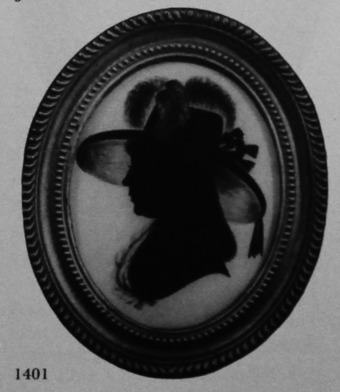
Unknown woman
Silhouette panited on plaster
? 1786 or 1788-89
3 ¾ x 2 ¾ in./96 x 70mm.
Trade Label No. 1
Frame: oval, hammered brass
As stated in the text, Thomason may have visited Manchester in 1786, 1788 and 1789.
J. A. Pollak collection
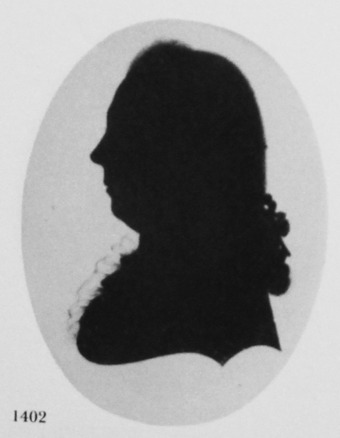
James Wyatt
Silhouette painted on plaster
August 1787
3 ½ x 2 ¾ in./ 90 x 70mm.
Frame: oval, hammered bras
Attributed to Thomason on stylistic grounds.
Author’s collection
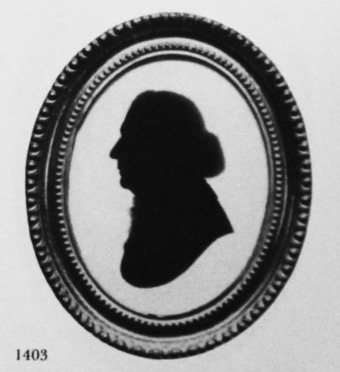
Unknown man
Silhouette painted on plaster
March-May 1790
3 ½ x 2 ½ in./90 x 64mm.
Trade Label NO. 2
Frame: oval, hammered brass
Crown Copyright. Victoria and Albert Museum, No. P41-1931
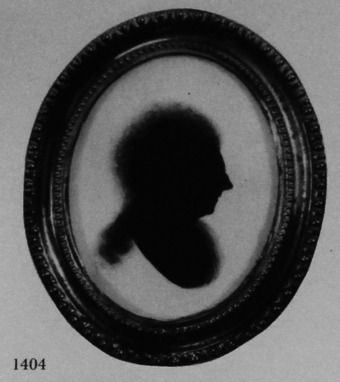
Unknown woman
Silhouette painted on plaster
1790-91
3 ½ x 2 ½ in./90 x 64mm.
Trade Label No. 3
Frame: oval, hammered brass
Author’s collection
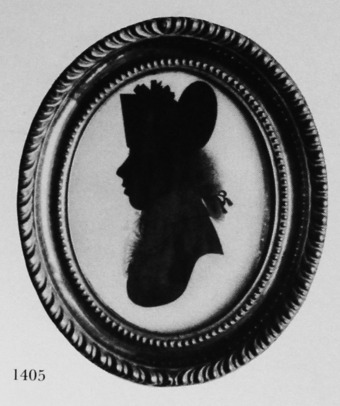
Unknown man
Silhouette painted on plaster
1790-91
3 ½ x 2 ¼ in./90 x 58mm.
Trade Label No. 3
Frame: oval, hammered brass
David Sargent collection
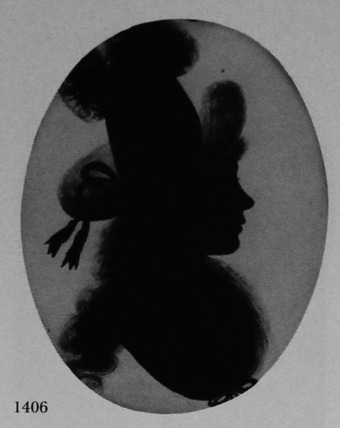
Unknown woman
Silhouette painted on plaster
1790-91
3 ½ x 2 ½ in./90 x 64mm.
Trade Label No. 3
Frame: oval, hammered brass
National Gallery of Ireland
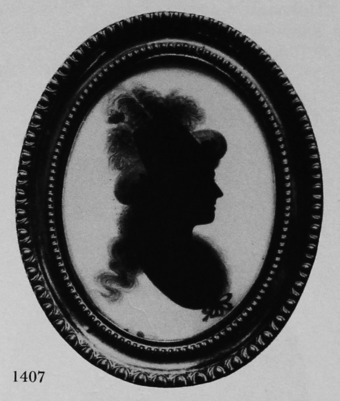
Unknown woman
Silhouette painted on plaster
1790-91
3 ½ x 2 ½ in./90 x 64mm.
Trade Label No. 3
Frame: oval, hammered brass
J. A. Pollak collection
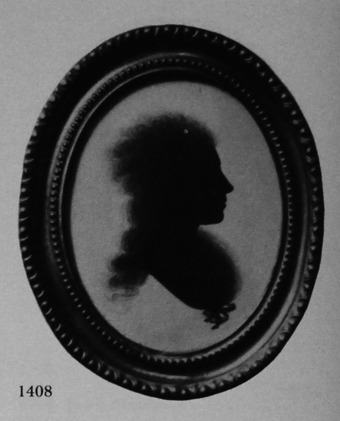
Unknown woman
Silhouette painted on plaster
1790-91
3 ½ x 2 ½ in./90 x 64mm.
Trade Label No. 3
Frame: oval, hammered brass
Thomason has painted the sitter’s hair with greater skill than usual.
From the collection of the late J. C. Woodiwiss
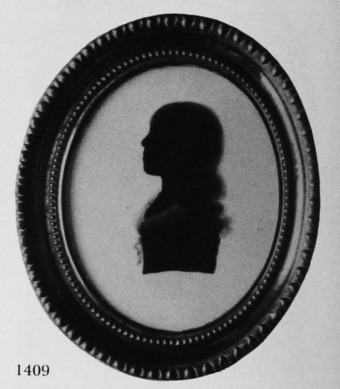
Unknown girl
Silhouette painted on plaster
1792-94
3 ½ x 2 ¾ in./90 x 70mm.
frame: oval, hammered brass
Though unlabelled, this silhouette can be attributed to Thomason on stylistic grounds.
Mrs Jean de Peyer collection
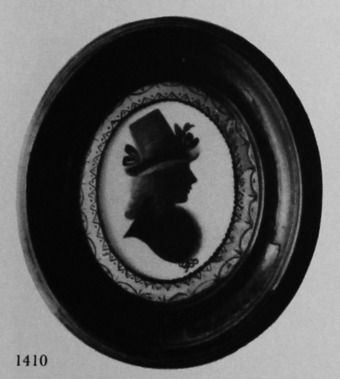
Unknown woman
Silhouette painted on plaster
c. 1793
3 x 2 ½ in./77 x 64mm.
Frame: pearwood, with verre églomisé border
Though unlabelled, this silhouette can be attributed to Thomason on stylistic grounds.
Donald Gildea collection
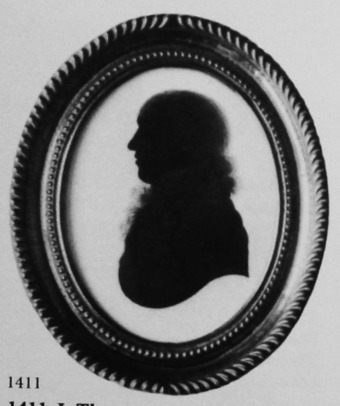
Unknown man
Silhouette painted on plaster
c. 1793-94
3 ½ x 2 5/8 in./90 x 67mm.
Trade Label No. 5
Frame: oval, hammered brass
Mrs Jean de Peyer collection
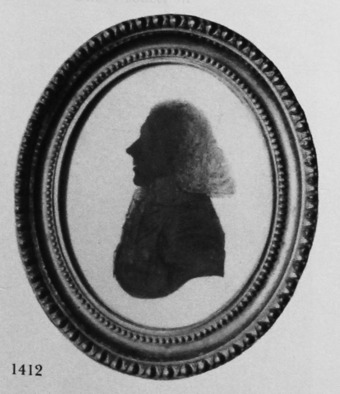
Will Donald
Silhouette painted on plaster
1794
3 ½ x 2 ¾ in./90 x 70mm.
Frame: oval, hammered brass
Inscribed with the sitter’s name and the date on the reverse. Although unlabelles, this silhouette and the silhouettes illustrated in 1413-1415 can safely be attributed to Thomason on stylistic grounds.
By courtesy of Elliott Levy
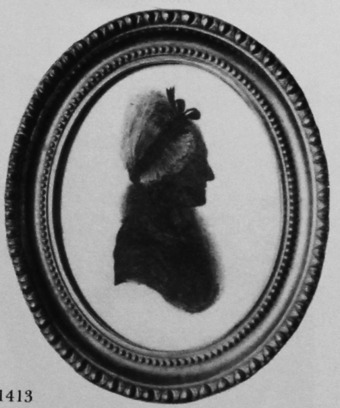
Mrs Will Donald
Silhouette painted on plaster
1794
3 ½ x 2 ¾ in./90 x 70mm.
Frame: oval, hammered brass
Inscribed on the reverse with the sitter’s name and the date.
By courtesy of Elliott Levy
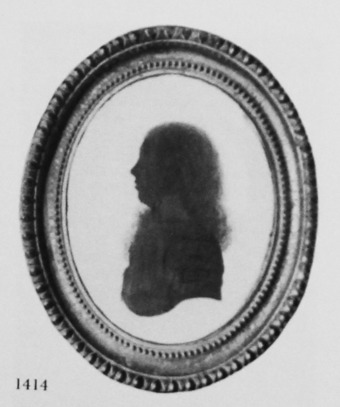
John Donald
Silhouette painted on plaster
April 1794
3 ½ x 2 ¾ in./90 x 70mm.
Frame: oval, hammered brass
The sitter was the son of Mr and Mrs Will Donald (1412-1413). Possibly the other three silhouettes of members of the Donald family (1412-1413, 1415) were also painted in April 1794.
By courtesy of Elliott Levy
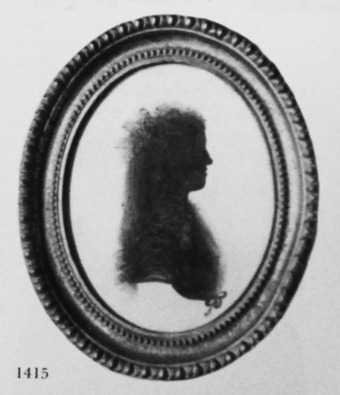
Jean Donald
Silhouette painted on plaster
? 1794
3 ½ x 2 ¾ in./90 x 70mm.
Frame: oval, hammered brass
The sitter was the daughter of Mr and Mrs Will Donald (1412-1413). Though undated, this silhouette can be assumed to be contemporary with the other silhouettes of members of the Donald family.
By courtesy of Elliott Levy
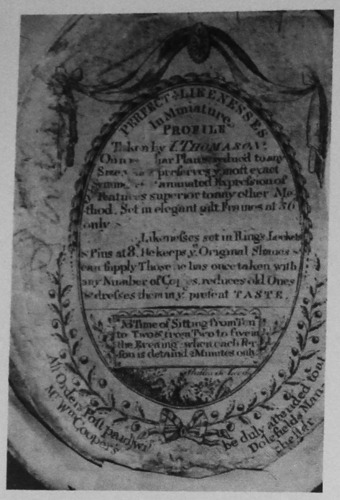
Trade Label No. 1 of J. Thomason.
J. A. Pollak collection
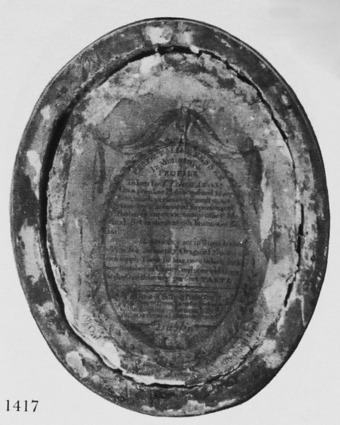
Trade Label No. 3 of J. Thomason.
Author’s collection
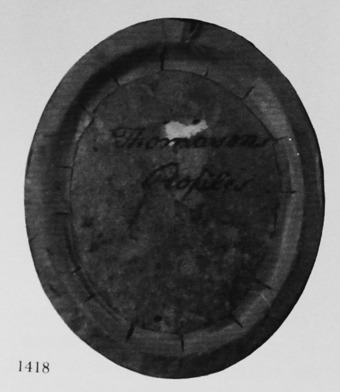
Trade Label No. 5 of J. Thomason.
Mrs Jean de Peyer collection
Detail
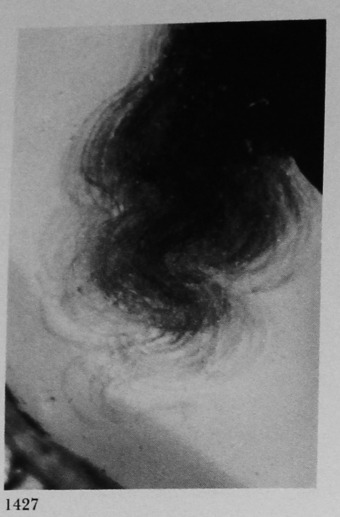
The à la conseilleur hair style. Detail from a silhouette of a woman by J. Thomason. The artist seems to have used two brushes of different thicknesses, reserving the thicker brush of painting dark masses of hair (producing a somewhat untidy effect). (1404)
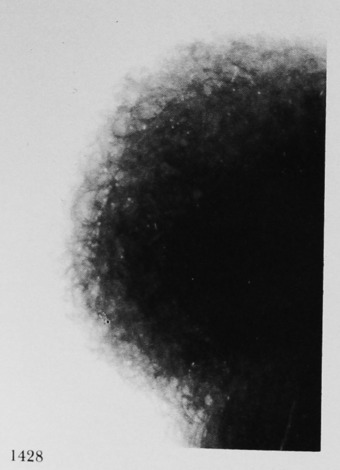
Back hair of a woman. Detail from a silhouette by J. Thomason. Compared with Houghton or Miers, Thomason uses a less restrained style when painting hair, which looks more wiry on his work than on theirs. (1404)
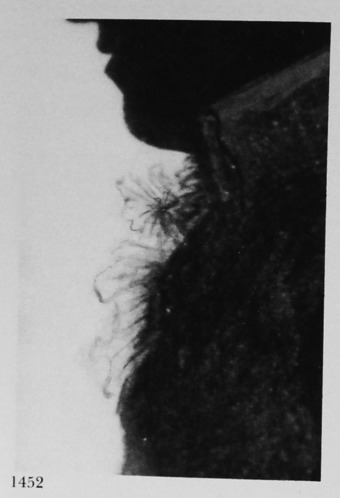
Shirt-frill. Detail from a silhouette of a man by J. Thomason, showing the confused handling which is characteristic of this artist’s work. His tratment of shirt-frills varies in style, and the texture of the clothing (of which part is visible in this illustration) is a surer guide to the identification of his work. (1411)
Mrs Jean de Peyer collection
